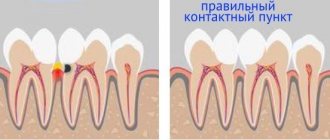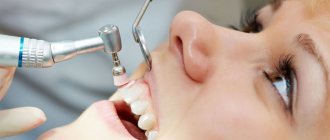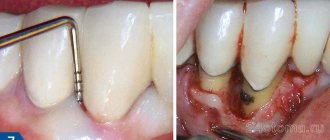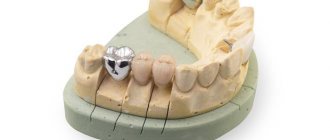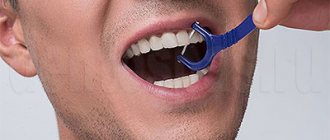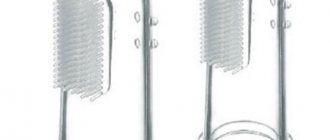Healthy teeth and a beautiful smile are not a gift from nature, they are daily care and proper protection. Daily brushing of your teeth using professional products, mouth rinses, and dental floss will help you protect your teeth from caries and other oral diseases. But, unfortunately, it is not always possible to completely clean your teeth even in the most secluded corners - this is how plaque appears on the teeth, and later tartar , which cannot be removed with a paste and brush. This will require professional teeth cleaning at the dentist's office.
To maintain the effect of the procedure and protect your teeth from various damage and diseases, you must follow a number of doctor’s recommendations, because teeth require special care after brushing. Family Dentistry Medical Center offers you a list of the most important tips:
Preventive measures
To avoid inflammatory processes in the oral cavity and relieve mild pain in the teeth, which sometimes occurs after removing tartar, you can rinse your mouth with medicinal decoctions, for example, St. John's wort, sage or even chamomile tea, which can be purchased at any pharmacy. If your teeth or gums continue to bother and hurt for a long time after hygienic cleaning, you should consult your doctor to make sure everything is okay.
Professional teeth cleaning, as well as home care, is an important and necessary procedure. By following all the doctor’s recommendations, not forgetting about the rules of hygiene, as well as regular preventive visits to the dentist and timely treatment, this is the only way you can protect your teeth from various diseases and defects. The health and beauty of your teeth depends on you, so take care of them from an early age!
Complex of symptoms
Increased sensitivity of teeth after cleaning from tartar can manifest itself in different ways. Most often, patients feel:
- discomfort when chewing food and brushing teeth,
- aching pain of varying degrees of intensity when leaving a warm room into the cold, eating hot and cold foods and drinks.
Normally, this condition can persist for 2-7 days. If enamel hyperesthesia does not go away or worsens over time, do not delay your visit to the dentist.
Why is tartar dangerous?
The formation of dental plaque, and then tartar, is possible for various reasons: the involvement of only one side of the jaw, left or right, in chewing; dietary habits, in particular, eating only soft foods; salt imbalance in the body; using low-quality toothbrushes; crooked teeth; smoking. And some people have a congenital predisposition to the appearance of stones. In such cases, even regular care does not guarantee the safety of teeth.
Microbes, which make up 95% of plaque, form acid during their life processes, which, due to tartar, cannot be neutralized by the alkaline environment of the oral cavity. As a result, the enamel is gradually destroyed, and a favorable environment for the formation of caries is formed. Tartar also negatively affects the gums - located between the gum and the tooth, it becomes overgrown with new plaque, which in turn penetrates the gums and causes inflammation. This creates an unpleasant odor in the mouth, gingivitis develops, and with further neglect, periodontitis.
The main reasons for the formation of tartar:
- Insufficient oral hygiene.
This also includes using the wrong toothbrushes. A brush that is too hard can regularly injure the enamel, increasing the sensitivity and vulnerability of teeth, while a brush that is too soft does not completely clean out even soft plaque, which results in the proliferation of bacteria in the mouth, caries and tartar.
- Poor nutrition.
Eating large amounts of fatty and sweet foods, the remains of which form a nutrient medium in the oral cavity for the growth and reproduction of microorganisms.
- Smoking.
The adhesive substances of nicotine resins are deposited on the tooth enamel in the form of a yellow film. Over time, this film, to which soft plaque adheres, mineralizes and turns into tartar.
- Chronic diseases of the digestive system and metabolic disorders are also provocateurs for the development of caries and tartar due to an imbalance in the acid-base balance in the mouth.
Hardened plaque has a mineral-salt composition, so it is impossible to deal with it yourself at home. Removing tartar in modern dentistry is a procedure that is as simple and painless as possible.
Mechanical stone removal
Mechanical method
Initially, tartar was removed only mechanically - using a special metal hook, which was used to separate the stone from the tooth. The procedure was quite painful and traumatic, so in recent years this method has not been popular; it has been replaced by more effective and much less traumatic ones.
Folk remedies for relieving gum pain
Simple folk recipes will also help relieve gum inflammation and soothe the tissues:
- Prepare a decoction of sage and chamomile by taking a tablespoon of the raw material and pouring a glass of boiling water over it. The herbs must be infused in a steam bath for 15-20 minutes, and then rinsed throughout the day. As a rule, the pain noticeably subsides after the third rinse.
- A solution of baking soda can quickly eliminate gum inflammation after professional teeth cleaning. It is enough to dissolve a teaspoon of baking soda in a glass of water and rinse your mouth with the mixture several times a day.
For acute inflammation of the gums, dentists advise using the unique ASEPTA gel with propolis. The product with the waste product of bees provides action in four directions: antimicrobial, anti-inflammatory, healing and analgesic.
We hope that gum inflammation after brushing your teeth will not torment you, and this hygiene procedure will become your usual care and a way to maintain a healthy, snow-white smile.
Sources:
- Report on clinical trials to determine/confirm the preventive properties of commercially produced personal oral hygiene products: mouth rinse "ASEPTA PARODONTAL" - Solution for irrigator." Doctor of Medical Sciences Professor, Honored Doctor of the Russian Federation, Head. Department of Preventive Dentistry S.B. Ulitovsky, doctor-researcher A.A. Leontiev First St. Petersburg State Medical University named after academician I.P. Pavlova, Department of Preventive Dentistry.
- Report on clinical trials of anti-inflammatory balm for gums "Asepta" adhesive, St. Petersburg State Medical University, 2007
- The role of anti-inflammatory rinse in the treatment of periodontal diseases (L.Yu. Orekhova, A.A. Leontyev, S.B. Ulitovsky) L.Yu. OREKHOVA, Doctor of Medical Sciences, Prof., Head of Department; A.A. LEONTIEV, dentist; S.B. ULITOVSKY, Doctor of Medical Sciences, Prof. Department of Therapeutic Dentistry of St. Petersburg State Medical University named after. acad. I. P. Pavlova
How is tartar formed?
Stone formation begins when plaque remains on the teeth after eating. At first soft and friable, in the absence of proper oral hygiene, it gradually reacts with the components of saliva, oxidizes and hardens. Over time, layers of plaque mineralize and tartar forms.
Plaque, which eventually turns into tartar, comes in two types:
- Subgingival
Plaque that can form on any tooth, regardless of its location. You won’t be able to detect it yourself; this can only be done by a doctor using a probe or gum recession.
- Supragingival
This plaque usually forms on the teeth closest to the salivary glands and has a yellowish or gray-brown tint. You can detect it in the oral cavity yourself, but it can only be removed with the help of a dentist.
What does tartar look like?
Tartar is a mineralized, dark-colored plaque on teeth. It is deposited mainly on the back side of the front teeth and in hard-to-reach interdental spaces; it consists of dead cells, bacteria and salts.
There is a misconception that tartar itself is not noticeable and not scary, and its presence does not in any way affect the health of the teeth. This misconception makes people not notice the growing plaque for years until the gums become inflamed in the affected area or a carious cavity forms. It is important to understand that tartar poses a serious danger to human health; it must be diagnosed promptly and disposed of immediately.
Increased tooth sensitivity after professional cleaning
After professional teeth cleaning, especially after cleaning the subgingival area, teeth may become overly sensitive for a while. Gradually this feeling will disappear and your teeth and gums will be healthier than before. If the increased sensitivity of teeth that occurs after professional oral hygiene persists longer than usual, the dentist will provide you with the necessary assistance and give recommendations.
Professional teeth cleaning
The only way to get rid of calcified plaque, that is, tartar, is to have your teeth professionally cleaned at your dentist's office. Tartar most often forms on the surface of teeth along the gum line or below the gum line, as well as in other areas that are difficult to reach with a toothbrush. The dentist or hygienist removes it using special instruments, scalers. This procedure is called scaling. The hygienist can also perform root smoothing - remove plaque and tartar from the top of the tooth roots by inserting an instrument between the tooth and the gum.
Before such treatment, the gums may be inflamed and swollen. Sometimes deep gaps, so-called periodontal pockets, even form between the gum and tooth, in which bacteria accumulate. Removing dental plaque and smoothing the root surface allows you to get rid of these problems, but the procedure itself can cause discomfort and bleeding gums. If the dentist has reason to believe that the cleaning process will be particularly unpleasant for the patient, he may use local anesthesia.
What happens next
General soreness, increased tooth sensitivity and bleeding gums are normal reactions of oral tissues to professional teeth cleaning. Some of these reactions are caused by the contact of instruments with inflamed gums that easily begin to bleed. Other reactions are due to the fact that as a result of this procedure, those areas of the teeth that were previously covered with plaque or tartar are exposed. Where gum recession occurs, scaling exposes the neck or root of the tooth, and it takes time for the teeth to adapt to the new condition. Since the neck and root are not protected by strong enamel, they are more sensitive than the crown of the tooth.
Sensitive teeth
Dentists believe that normally, bleeding, discomfort and increased sensitivity of teeth after professional oral hygiene can last no longer than a week. With careful and regular oral hygiene, swelling, hypersensitivity and bleeding of the gums gradually decrease, but the feeling of general discomfort in most patients disappears in one or two days. As for increased tooth sensitivity, in everyday life - especially when drinking hot drinks and cold food, chewing food and brushing teeth - it is quite difficult to avoid unpleasant sensations, but after a week they should stop bothering you.
Caring for your teeth after professional cleaning
Careful dental care following professional oral hygiene helps gums heal by reducing exposure to irritants that cause pain and sensitivity. Stop flossing for at least a day; While your gums are still sore, gently brush your teeth using a soft-bristled brush and a special toothpaste for sensitive teeth. Avoid foods and drinks that cause discomfort. If tooth sensitivity persists for more than a week after professional cleaning, or if other problems arise, make a follow-up appointment with your dentist, who will check how well your gums are healing and possibly apply a special professional solution to sensitive areas of your teeth.
Teeth hypersensitivity after professional cleaning is not a problem that requires immediate medical intervention: you can cope with it yourself by using a special toothpaste and watching your diet. If symptoms persist for more than a week, contact your dentist, but remember that discomfort may also be caused by mistakes you made during oral care.


